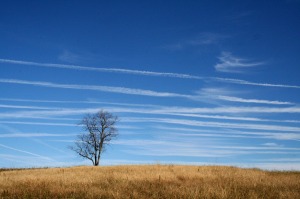Dynamic Setting
When I first started slinging verbiage onto my computer, my setting wasn’t integral. Well, that’s a bit of a stretch. More truthfully, the truth or actuality of the location didn’t matter. I got my story on paper first, then later during editing, I spoke to a good friend who lives in the general area where my book takes place. That is the benefit of using a completely fictional location, no one can really argue that that portion of Kansas has the topography I describe. Only I (and my good friend whom I interviewed) have any idea where fictional Little Springs is.
I found that picture above just before I set this to post, but it is exactly as I picture the Kansas in my mind. Very gently rolling prairie with a hint of trees in the distance to delineate some type of water, with relatively few trees. The friend I spoke to confirmed that where she lives in Kansas it is very much like that. It became important to me after it was written that the topography of my Kansas be accurate, but having a fictitious area has drawbacks as well.
I know that no matter how well I set the scene, someone from Kansas is going to complain that it isn’t like that. Especially if the way they feel in their home or area is not represented. Topography can vary greatly even within a ten mile radius. How can I be accurate, yet vague enough to please the masses?
In my first draft, I mentioned which part of the state Little Springs was supposed to be in, I’ve since cut that. I’ve also kept most of my descriptions to the sky, which is somewhat universal and only to the actual swelling and dipping of the homestead and its surrounding river and trees at a minimum.
If I may have a bit of leeway here on my own blog, I’d like the indulgence of describing in full how I see Whitte Ranch. It is roughly one hour’s ride outside this small town of Little Springs. The ranch sits on the edge of a small creek where the cattle and horses have a water source. The early 1900’s brought about the era of fences which is good, because I pictured vast, green, rolling pastures for cattle. A massive, rustic barn with an attached stable sits in front of the house and a bunkhouse is to the right of that. The chicken coop is at the back of the house and off about thirty feet, as is the root cellar. The large house garden can also be found there.
The home itself is a log home, two-story, with a porch that wraps all the way around the front and the side of it, but you can’t see the side porch as you approach the house from the drive. The porch is scattered with miss-matched chairs and rockers, one swing hangs in front to the left of the front door. The entire area between the ranch house and the barn is like gravel.
One interesting feature of Whitte Ranch that isn’t most likely accurate to most other ranches of the time, they don’t have a dog. Dogs would have been used to herd cattle and for general protection. There are points in the novel where a dog would have been nice, but they don’t have one.
There is a small rise behind the chicken coop that is the highest area for miles. It eventually gets dubbed Margot’s hill. The other feature of the land is that the drive between the road and the ranch house is long and a berm is cut in the rock of the old creek bed that prevents you from seeing the house if you were driving by in a wagon.
Now you know a little of the setting. If you are interesting in seeing more visually how I picture the characters, setting and important images of To Honor and Cherish, please visit my Pinterest page dedicated to it, here.
How do you deal with setting and topography? Do you like a lot of description in the books you read or do you prefer to leave it to your imagination?


